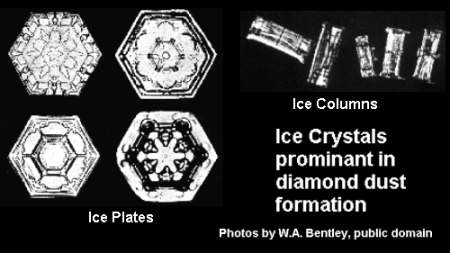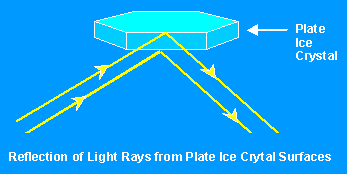 |
 |
| Home | Welcome | What's New | Site Map | Glossary | Weather Doctor Amazon Store | Book Store | Accolades | Email Us |
 | |||||||||
Diamond DustDuring the depths of January cold, we often hear some self-proclaimed weather sage observe, "It's too cold to snow." At first, the statement appears to jive with general experience. Are not the coldest days and nights clear and dry? While this is generally true — large, frigid arctic airmasses are usually characterized by dry, mostly clear weather — it is not the cold that prevents snow falling in these airmasses, but the lack of ascending air to start the precipitation process. Truth is, it is never too cold to snow, though the conditions which bring the coldest temperatures are usually non-conducive to producing precipitation. But, it is also true that the colder the temperatures, the less water vapour the air may contain. In fact, the amount of water vapour at saturation drops by about a factor of two for every 10 Celsius degrees (18 Fahrenheit degrees) drop in air temperature. At very cold temperatures, 40o below zero (C or F) and colder, snow can actually fall out of the cleanest, clearest blue sky without intervening clouds. Temperatures need not be so cold if there is dust, or other minute particles, in the air on which the water vapour may deposit. When condensation nuclei are present, diamond dust may form at temperatures just below minus 20oC (0 oF). At such temperatures, the water vapour in the air spontaneously forms ice crystals which slowly settle earthward. When these falling crystals are caught in the light, they sparkle like gemstones, a weather condition known appropriately enough as diamond dust. I recall one frigid arctic outbreak in southern Ontario when the temperature barely hovered around minus 20oC ( minus 4oF). As I walked home in the late afternoon, the soon-to-be-setting sun illuminated the horizon in brilliant light through the crystal-clear sky. Looking beyond my parka hood, I noticed a soft flutter of snow encircled me. The snow, so fine that individual crystals were distinct on my dark coat sleeve, floated around me gently and slowly drifting earthward. In the brilliant sunlight, the snow crystals glittered against the darkening sky.  At such low temperature, ice crystals form as irregular hexagonal plates, or as unbranched ice needles or ice columns directly from water vapour in the air. The formation of hexagonal-plate crystals is favoured at air temperatures from minus 10oC to minus 20oC (14oF to minus 4oF). Ice plates resemble dinner plates with a hexagonal pattern in their long dimension and are thin relative to their width. Ice columns, on the other hand, look like minute stubby pencils. Columns typically form in temperatures below minus 25oC ( minus 13oF). They are long in comparison to their hexagonal cross-section. Larger column crystals fall with their long axis parallelling the ground, but at times, the falling columns may rotate like slow, miniature helicopter blades. When the hexagonal plates and columns are less than 20 micrometres across — so small that ten can fit, side-by-side, on the edge of a sheet of paper — the plate crystals tumble randomly through the air as they fall, catching and reflecting the solar beam. But when the crystals are somewhat larger, they fall so that their long dimension parallels the ground, floating downward like descending flying saucers. Larger column crystals fall with their long axis parallelling the ground, but at times, the falling columns may rotate like slow, miniature helicopter blades. As I continued walking homeward, the descending sun was only minutes away from setting. Looking westward, I saw a crimson pillar of light rising above the solar disk. This was a sun pillar, a feather of light that extends vertically above, and at times below, the sun. Sun pillars are the most common form of light pillar, though they can form in moonlight and strong artificial light as well. (For more on light pillars, see my article by clicking here.) Most sun and moon pillars are seen when the source is low on the horizon (about 1 to 2 degrees above) and generally extend only 5 to 10 degrees directly above it.  Light pillars appear when the larger ice crystal plates and columns assemble in a stable "flying formation" and strong light passes through the formation from the source toward the observer. The ice crystals act like small mirrors, reflecting the light rays as they hit the crystal's upper or lower surfaces at a grazing angle. Light pillars may form in situations when diamond dust is present in the air, but they more commonly appear when blowing snow raises ice crystals or when thin cirrus clouds containing such crystals are near the horizon between the observer and light source. (When pillars form from crystals in cirrus clouds, they may be seen in all seasons.) Learn More From These Relevant Books
|
|||||||||
 |
To Purchase Notecard, |
Now Available! Order Today! | |
 |
 |
NEW! Now Available in the US! |
The BC Weather Book: |


